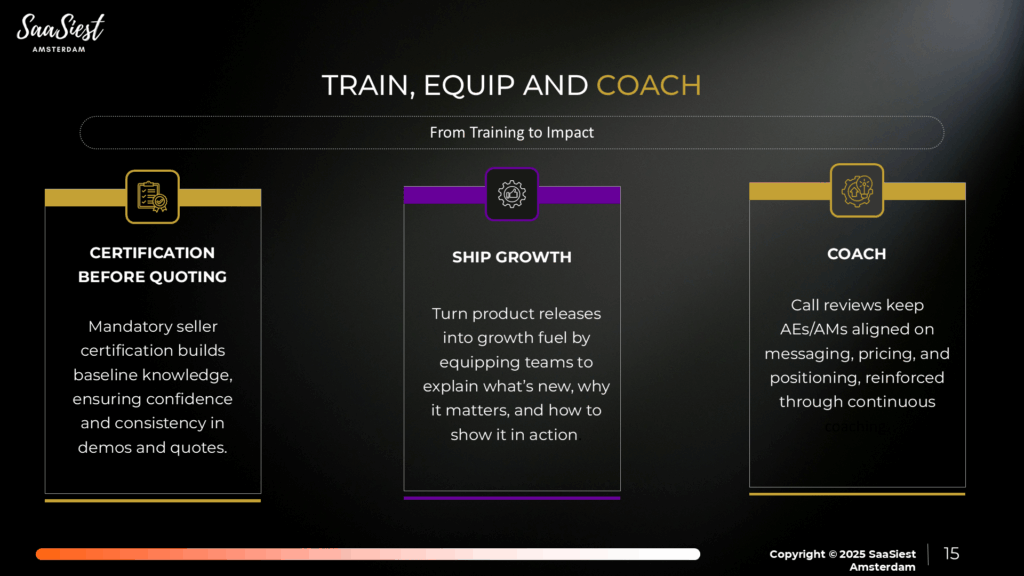When SaaS growth stalls, the problem is rarely demand. It’s usually friction inside the revenue engine.
Deals sit idle in the pipeline. Teams chase bad-fit customers. Pricing confuses more than it converts. Marketing, sales, and customer success work in silos, and everyone thinks the problem is someone else’s.
Flora Nkuranga Gaju, EVP of Global Sales and Client Success at Chili Publish, has seen that chaos firsthand. Over the past seven years, she has led the company through multiple stages of growth, overseeing everything from first contact to renewal.
At SaaSiest Amsterdam 2025, she shared how her team eliminated time traps, unified sales and success under one revenue motion, and built a RevOps backbone that made growth predictable again.

The problem: Time traps hiding in plain sight
When Flora began auditing Chili’s go-to-market process, the issues looked familiar but painful.
- Slow lead handling and no visibility into missed SLAs
- Stage aging with no next steps or ownership
- Confusing pricing that drained hours from every deal cycle
- Fragmented tools across sales, marketing, and CS that broke communication
- Poor enablement, where teams didn’t understand the product before selling it
The result was predictable: long sales cycles, high churn, and a pipeline that looked impressive but meant little. “We were attracting bad-fit customers and giving them a poor experience,” Flora said. “And we were wasting time at every stage.”
It wasn’t one broken process – it was a system that didn’t run as one.
Step one: Audit, align, and reset incentives
Flora began by running a full top-to-bottom audit with every customer-facing leader. “You can’t fix what you can’t see,” she said. The audit revealed overlapping responsibilities, unclear ownership, and incentives that encouraged short-term wins over long-term success.
The first move was unifying sales and success under one revenue leadership structure. Instead of having separate VPs for Sales and Client Success, Chili moved to a single revenue leader accountable for both new ARR and expansion.
The change forced clarity. Account executives were now responsible only for signing new logos, while the account management team owned onboarding, renewals, and churn prevention.
Then came a critical shift in incentives. Pre-sales engineers, formerly rewarded for new deals, were now compensated on total revenue, whether it came from new or existing customers. “That stopped us from signing bad-fit clients just to close deals,” Flora explained.
To operationalize this, the team introduced a fit scoring system.
- Green meant a clear fit and technical approval.
- Orange indicated limited fit and required leadership review.
- Red meant no-go.
No orange or red opportunity could proceed without executive sign-off. This small rule alone prevented weeks of wasted pipeline effort and costly churn later.

Step two: Remove unnecessary handoffs
The next bottleneck lived in the handoffs. Leads passed from BDRs to AEs, then from AEs to post-sales. Each stage added repetition and delay.
Flora scrapped the traditional BDR-to-AE model entirely. Account executives now owned the full cycle – from qualification to close. They sourced, demoed, negotiated, and closed their own deals.
“BDRs were pre-qualifying leads and AEs were waiting for meetings instead of creating them,” Flora said. “It was comfortable, but inefficient.”
On the post-sale side, a clearly defined handover process ensured that every new customer moved seamlessly into onboarding. By the time a deal was signed, the onboarding plan was already outlined, with responsibilities, milestones, and kickoff dates in Salesforce.
The goal was simple: zero surprises for the customer after signature.
Step three: Strengthen RevOps as the company’s nervous system
Flora calls Revenue Operations the backbone of the business – the part that turns opinions into data-backed decisions.
Even a mid-level RevOps hire, she argued, can change everything. At Chili, the RevOps team introduced SLA compliance dashboards to track lead handling in real time. If an SLA was missed, leadership was alerted immediately.
Dashboards became the glue holding the entire revenue engine together:
- Pipeline health reports showing where deals were stuck and why.
- Onboarding journey tracking from kickoff to “live,” exposing where customers struggled to reach value.
- Revenue insights combining new ARR and net retention.
Every AE could now see exactly how close they were to quota, which opportunities were slipping, and which needed executive help. “It made one-on-ones faster, sharper, and data-driven,” Flora said.
RevOps also became the connector between systems. Chili consolidated marketing, sales, and success into Salesforce, integrated with ActiveCampaign for marketing automation and OneFlow for contracting. Instead of endless Word document revisions, contracts were now collaborative and tracked end-to-end.
Automation tools like Calendly replaced manual scheduling, saving time across thousands of customer interactions.
Step four: Simplify everything – especially pricing
One of the biggest time traps was Chili’s pricing model. It was complex, opaque, and required lengthy explanations. “Any price book that takes more than five minutes to explain is too complicated,” Flora said.
The team worked with external experts to redesign and simplify pricing, then made it public on the website. Prospects arrived knowing what to expect, which eliminated endless “how much does it cost?” conversations.
By the time a lead reached sales, the discussion had already shifted from price to value. Transparency accelerated trust and filtered out poor fits before they even booked a call.

Step five: Train, certify, and coach relentlessly
Even the best process fails if people can’t execute it. Flora invested heavily in enablement that sticks.
Every new AE or AM must now pass certification before being allowed to quote. Chili built an internal LMS where employees train on new features, customer use cases, and value stories.
When new product features launch, go-to-market teams are trained not just on what the feature does, but why it matters and what outcome it drives.
Ongoing one-on-one coaching reinforces consistency in messaging, pricing, and storytelling. “If your people can’t pitch your value clearly, it’s not a sales problem, it’s an enablement problem,” Flora said.
Step six: Track what matters and make it visible
The new dashboards didn’t just improve data – they created ownership.
Every AE starts their day seeing:
- Active opportunities
- Lead-to-conversion ratios
- Quota progress
- Missed SLA alerts
Every account manager can track onboarding progress, customer health scores, and upcoming renewals. The leadership team monitors deal velocity, conversion rates, and expansion opportunities from the same system.
“Dashboards are not reports,” Flora said. “They are the nervous system of the business. They make accountability visible.”
The outcome
By removing handoffs, unifying incentives, simplifying pricing, and investing in RevOps, Chili transformed how revenue moved through the organization.
- Pipeline speed increased dramatically through faster qualification and SLA discipline
- Sales and success teams finally operated as one, improving both win rates and retention
- Time traps disappeared, freeing leaders to focus on growth, not firefighting
- Visibility and accountability increased across every function
Revenue Operations became not just a function but a philosophy: a single system of truth powering every step from quota to renewal.
Final takeaway
Revenue efficiency is not about doing more. It’s about removing what slows you down.
Flora’s playbook proves that when you unify ownership, simplify pricing, eliminate handoffs, and make data visible, growth follows naturally.
“Never let deals stall,” she said. “Audit your time traps, train your people, and track what matters. That’s how you build a revenue engine that actually works.”
Watch the full session from SaaSiest 2025 here: https://saasiest.com/from-quota-to-renewal-building-a-revenue-org-that-actually-works/




